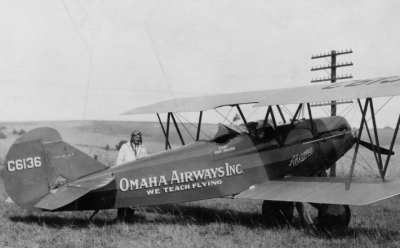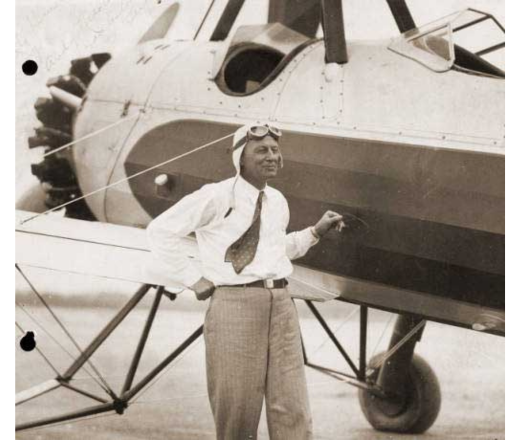

At the end of World War I, the military was left with a surplus of Curtiss JN-4 “Jenny” biplanes which were sold for a fraction of their original value, mostly to the military aviators who trained in them. These planes, which had been instruments of war, became a popular form of entertainment in the Roaring 20’s, as daredevil pilots sold airplane rides and performed stunts at “barnstorming” events across the country.
Lieutenant Andy Nielsen of Council Bluffs returned from the War in 1919 with his own surplus plane, purchased from the Canadian Government, and put it to use thrilling audiences at Lake Manawa. According to local newspaper reports, this still-novel form of travel created, “a great sensation,” as people lined up to see the plane.
Nielsen pioneered aviation in the area, building the first landing strip and hanger in Pottawattamie County on pasture land he rented near Lake Manawa. As the founder of Nielsen Aero Company and Omaha Airways in Nebraska, Nielsen explored the commercial viability of air travel, anticipating the age of commercial flight.
When Andy Nielsen signed up to join the war effort in 1917 at the age of 28, his draft card listed his occupation as “Minister.” In later interviews, Andy stated that he received mixed marks while training in San Diego because he could not resist the temptation to perform areal stunts against his instructor’s wishes.
After the war, Andy returned to ministering at the Methodist church. When he wasn’t preaching about heaven in church, he was flying though the heavens in his Jenny. However, the Methodist conference told the pilot preacher that he must choose; he had to quit flying or quit preaching. Nielsen responded with a heated telegram in which he compared the conference to the German government. After this bitter departure, Andy devoted all of his attentions to aviation. In a peace-making gesture, he offered free airplane rides to any minister in the city stating, “I’ll make real sky pilots of them.”
Barnstorming attracted larger than life characters who made their livings selling thrill and spectacle, and Andy was no exception. In 1919, Andy invited the staff of the Nonpareil newspaper to fly with him. One brave volunteer agreed, but not before preparing his own obituary and sharing it with his editors in case the flight should end badly. Soon after takeoff, the reporter found himself in a dive “headed directly, earnestly and persistently at the center of Fairview cemetery.” After landing safely at Lake Manawa, the reporter recommended the experience to his readers, stating, “Those who have no dependents should avail themselves of a trip with Council Bluffs’ own aviator.”
Lieutenant Nielsen performed many publicity stunts to promote his business. In March of 1921, the first pitch of the opening baseball game of the Council Bluffs Nonpareils was thrown from a player riding in Andy’s plane. At a game later in the season, Andy performed aerial stunts during the 8th inning, ending with a player jumping from the wing and parachuting to the ball diamond.
While Lieutenant Nielsen made money selling airplane rides and performing at air circuses, he also experimented with the commercial viability of the airplanes as tools of transportation, advertising, and delivery. In 1920, Nielsen partnered with the Woodward Candy Company to experiment with delivering goods via air. The plan was to build a landing strip on top of the south Woodward building, extending from Park Avenue to Glen Avenue. There were trial flights to test the elevated landing, but the platform was never built.

Nielsen also sold his services to advertisers, and dropped countless leaflets across the city. An assistant recalled, “How many orders for hams and suspenders and Dodge cars and shaves and coal hods and pot cleaners and ice cream sodas we threw out I don’t know. There were scads of them … the big sheets got mixed up with tail dew-dads, so that we had to work a trick on it.”
At the time, one of the most popular activities in rural America was the Chautauqua circuit – a community gathering that brought speakers, teachers, musicians, preachers, and entertainers to speak and perform in large tents. Nielsen was the first to fly an airplane over the Chautauqua circuit, displaying air stunts in the afternoon and lecturing at night about navigation before huge crowds. Though commercial aviation would not take off until after the next world war, these lectures exposed people to the possibilities of civilian air travel, and invited them to imagine a world of rapid mass transportation.
In the end, the airport at Lake Manawa was a financial failure. Andy allowed his plane to be taken by creditors and he enrolled at Creighton University to study law. He graduated in 1925, and practiced law in Omaha and Council Bluffs. In 1926 he moved to Nebraska and established Omaha Airways Corporation. He is quoted as saying the lure of the air was too strong and he had to “get back into the game.”
For some who accompanied Nielsen on plane rides, the experience of leaving the earth was exhilarating. “It was just wonderful,” said Dolly Schuttloffel of Walnut. But for others, the experience was a little too exciting. During a flight with Andy, Mrs. James Gunn of Council Bluffs became airsick. On her drive back home, she was so shaken by the experience that she crashed a car, injuring herself and two others, and infuriating her husband. And in 1928, a business flying from Chicago to Detroit on Andy’s plan had a heart attack and died, forcing an emergency landing.
Aviator Charles Lindbergh (once a barnstormer himself) caused a sensation in 1927 when he flew from New York to Paris in the first solo transatlantic flight and the first non-stop flight between North America and Europe. This feet led to a wave of endurance records, as aviators across the country tried to break the record for the longest refueled flight. In July of 1929, aviators from California stayed in the air for 10 days. Andy Nielsen was convinced that he could top this record, and approached the Curtis airplane company about sponsoring the attempt. Just days later, the record was broken again (this time over 17 days of continuous flight), and Andy abandoned the idea.
Nielsen had problems in his personal life, including two messy divorces, some near accidents, and a knife fight with a Native American business owner – all of which made headlines. But he settled down later in life, serving eight years in the Iowa Legislator. Nielsen retired at the age of 76, having been a minister, a soldier, an aviator, a lawyer, a legislator, and a judge. In not seeking reelection, he said he felt it was time, “for a younger man to step into the job,” and, “I’m tired.”
Click HERE for more information on Council Bluffs History.